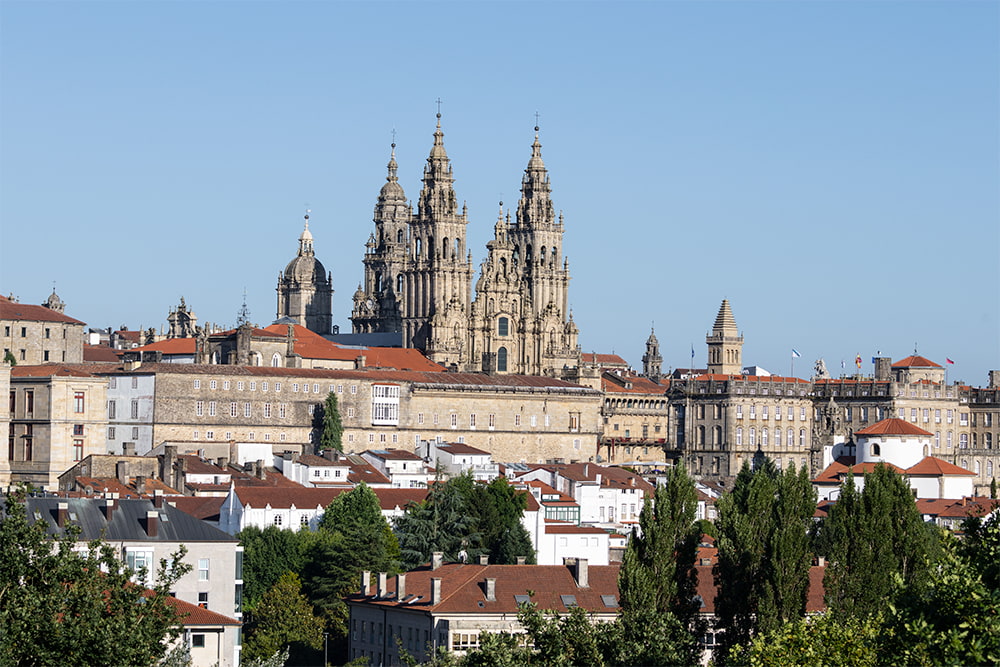
Although the Cathedral of Santiago de Compostela is the undisputed star of the city, declared a World Heritage Site in 1985 and a jewel of Romanesque art, the Galician capital is much more than its cathedral. The city offers an endless number of historical, cultural and natural corners that deserve to be discovered.
If you plan to visit Santiago, here is a guide to help you make the most of your experience and discover other points of interest in the city.
Plaza del Obradoiro
Besides being the square that houses the cathedral, the Plaza del Obradoiro is a place full of history and a visual delight thanks to its architecture. Its name seems to derive from the stonemasons’ workshops that worked on the construction of the Cathedral’s baroque façade.
Here you can admire the imposing Pazo de Raxoi, which houses the town hall; the Pazo de Xelmírez, former episcopal palace of the cathedral; and the Colexio de San Xerome, former high school of the city and a magnificent example of Galician Renaissance architecture.
Mercado de Abastos
If you are passionate about gastronomy, the Mercado de Abastos is a must. Dating back to the 19th century, this market is the ideal place to discover the local flavors and typical products of Galicia.
From fresh seafood to sausages and cheeses, you can enjoy the authentic Galician culinary essence.
Old town
The old town of Santiago unfolds around the Plaza del Obradoiro, and getting lost in its narrow cobblestone streets is one of the most authentic experiences the city has to offer.
You will feel the magic and charm of its squares, buildings and small stores. You can even transport yourself back in time and enjoy its medieval atmosphere.
Plaza de Platerías
The Plaza de Platerías, the square south of the cathedral, is one of the most picturesque corners of the city. It is notable for its elegant Renaissance-style buildings, and is named after the silversmiths who once worked in the area. It is dominated by the only remaining Romanesque facade of the cathedral.
It is an ideal place to stop, enjoy the facades of the surrounding buildings and admire the impressive Fuente de los Caballos in the center of the square.
Plaza de la Quintana
Another square full of history is the Plaza de la Quintana. Once upon a time, it was the great cemetery of the city. For this reason, the upper space, which is at the bottom of the stairs, is known as “Quintana dos Vivos” and, the large esplanade that we stepped on, “Quintana de Mortos”.
Here we also find the Puerta Santa, one of the main entrances to the cathedral, which is only opened during the Holy Year so that believers who cross it can receive plenary absolution after confession and communion.
Monastery and Church of San Martiño Pinario
The Monastery of San Martiño Pinario is one of the most impressive monasteries in Santiago. Its church houses a magnificent collection of sacred art, and the building itself, with its facade and imposing size, reflects the religious importance it had in the history of the city.
Undoubtedly, it is an architectural jewel that deserves to be visited.
Parque de la Alameda
If you are looking for a place to relax and enjoy spectacular views of the city, the Parque de la Alameda is the perfect place to stroll in a quiet environment. From its viewpoints, you can contemplate the silhouette of the cathedral, surrounded by the park’s vegetation.
Here you will find the statue of Las dos Marías, the most famous sisters of Santiago.
Parque de Santo Domingo de Bonaval
In the heart of Santiago, the Parque de Santo Domingo de Bonaval is a haven of peace. Apart from its beautiful gardens and views, this park is home to the Museo do Pobo Galego, which we will talk about next.
This former convent of Santo Domingo is an essential stop for lovers of history and anthropology, as it sits under the old orchard of the monastery and cemetery that the Dominicans founded in the city.
Museo do Pobo Galego
Located in the former convent of Santo Domingo de Bonaval, the Museo do Pobo Galego is a place to delve into the history and traditions of Galicia.
Highlights include its impressive triple helical staircase and the museum’s church, which houses the remains of important Galician figures such as the writer Rosalia de Castro.
And that’s as far as our little must-see guide goes! Get ready to be enchanted by the magic of Santiago de Compostela.